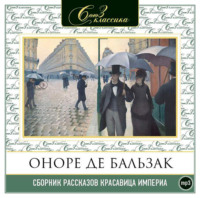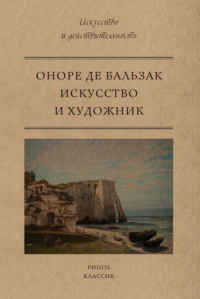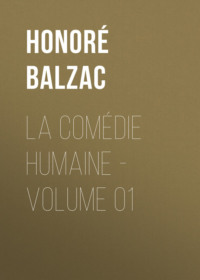 полная версия
полная версияBeatrix

Honoré de Balzac
Beatrix
It is somewhat remarkable that Balzac, dealing as he did with traits of character and the minute and daily circumstances of life, has never been accused of representing actual persons in the two or three thousand portraits which he painted of human nature. In “The Great Man of the Provinces in Paris” some likenesses were imagined: Jules Janin in Etienne Lousteau, Armand Carrel in Michel Chrestien, and, possibly, Berryer in Daniel d’Arthez. But in the present volume, “Beatrix,” he used the characteristics of certain persons, which were recognized and admitted at the time of publication. Mademoiselle des Touches (Camille Maupin) is George
Sand in character, and the personal description of her, though applied by some to the famous Mademoiselle Georges, is easily recognized from Couture’s drawing. Beatrix, Conti, and Claude Vignon are sketches of the Comtesse d’Agoult, Liszt, and the well-known critic Gustave Planche.
The opening scene of this volume, representing the manners and customs of the old Breton family, a social state existing no longer except in history, and the transition period of the vieille roche as it passed into the customs and ideas of the present century, is one of Balzac’s remarkable and most famous pictures in the “Comedy of Human Life.”
K.P.W.
I. A BRETON TOWN AND MANSION
France, especially in Brittany, still possesses certain towns completely outside of the movement which gives to the nineteenth century its peculiar characteristics. For lack of quick and regular communication with Paris, scarcely connected by wretched roads with the sub-prefecture, or the chief city of their own province, these towns regard the new civilization as a spectacle to be gazed at; it amazes them, but they never applaud it; and, whether they fear or scoff at it, they continue faithful to the old manners and customs which have come down to them. Whoso would travel as a moral archaeologist, observing men instead of stones, would find images of the time of Louis XV. in many a village of Provence, of the time of Louis XIV. in the depths of Pitou, and of still more ancient times in the towns of Brittany. Most of these towns have fallen from states of splendor never mentioned by historians, who are always more concerned with facts and dates than with the truer history of manners and customs. The tradition of this splendor still lives in the memory of the people, – as in Brittany, where the native character allows no forgetfulness of things which concern its own land. Many of these towns were once the capitals of a little feudal State, – a county or duchy conquered by the crown or divided among many heirs, if the male line failed. Disinherited from active life, these heads became arms; and arms deprived of nourishment, wither and barely vegetate.
For the last thirty years, however, these pictures of ancient times are beginning to fade and disappear. Modern industry, working for the masses, goes on destroying the creations of ancient art, the works of which were once as personal to the consumer as to the artisan. Nowadays we have products, we no longer have works. Public buildings, monuments of the past, count for much in the phenomena of retrospection; but the monuments of modern industry are freestone quarries, saltpetre mines, cotton factories. A few more years and even these old cities will be transformed and seen no more except in the pages of this iconography.
One of the towns in which may be found the most correct likeness of the feudal ages is Guerande. The name alone awakens a thousand memories in the minds of painters, artists, thinkers who have visited the slopes on which this splendid jewel of feudality lies proudly posed to command the flux and reflux of the tides and the dunes, – the summit, as it were, of a triangle, at the corners of which are two other jewels not less curious: Croisic, and the village of Batz. There are no towns after Guerande except Vitre in the centre of Brittany, and Avignon in the south of France, which preserve so intact, to the very middle of our epoch, the type and form of the middle ages.
Guerande is still encircled with its doughty walls, its moats are full of water, its battlements entire, its loopholes unencumbered with vegetation; even ivy has never cast its mantle over the towers, square or round. The town has three gates, where may be seen the rings of the portcullises; it is entered by a drawbridge of iron-clamped wood, no longer raised but which could be raised at will. The mayoralty was blamed for having, in 1820, planted poplars along the banks of the moat to shade the promenade. It excused itself on the ground that the long and beautiful esplanade of the fortifications facing the dunes had been converted one hundred years earlier into a mall where the inhabitants took their pleasure beneath the elms.
The houses of the old town have suffered no change; and they have neither increased nor diminished. None have suffered upon their frontage from the hammer of the architect, the brush of the plasterer, nor have they staggered under the weight of added stories. All retain their primitive characteristics. Some rest on wooden columns which form arcades under which foot-passengers circulate, the floor planks bending beneath them, but never breaking. The houses of the merchants are small and low; their fronts are veneered with slate. Wood, now decaying, counts for much in the carved material of the window-casings and the pillars, above which grotesque faces look down, while shapes of fantastic beasts climb up the angles, animated by that great thought of Art, which in those old days gave life to inanimate nature. These relics, resisting change, present to the eye of painters those dusky tones and half-blurred features in which the artistic brush delights.
The streets are what they were four hundred years ago, – with one exception; population no longer swarms there; the social movement is now so dead that a traveller wishing to examine the town (as beautiful as a suit of antique armor) may walk alone, not without sadness, through a deserted street, where the mullioned windows are plastered up to avoid the window-tax. This street ends at a postern, flanked with a wall of masonry, beyond which rises a bouquet of trees planted by the hands of Breton nature, one of the most luxuriant and fertile vegetations in France. A painter, a poet would sit there silently, to taste the quietude which reigns beneath the well-preserved arch of the postern, where no voice comes from the life of the peaceful city, and where the landscape is seen in its rich magnificence through the loop-holes of the casemates once occupied by halberdiers and archers, which are not unlike the sashes of some belvedere arranged for a point of view.
It is impossible to walk about the place without thinking at every step of the habits and usages of long-past times; the very stones tell of them; the ideas of the middle ages are still there with all their ancient superstitions. If, by chance, a gendarme passes you, with his silver-laced hat, his presence is an anachronism against which your sense of fitness protests; but nothing is so rare as to meet a being or an object of the present time. There is even very little of the clothing of the day; and that little the inhabitants adapt in a way to their immutable customs, their unchangeable physiognomies. The public square is filled with Breton costumes, which artists flock to draw; these stand out in wonderful relief upon the scene around them. The whiteness of the linen worn by the paludiers (the name given to men who gather salt in the salt-marshes) contrasts vigorously with the blues and browns of the peasantry and the original and sacredly preserved jewelry of the women. These two classes, and that of the sailors in their jerkins and varnished leather caps are as distinct from one another as the castes of India, and still recognize the distance that parts them from the bourgeoisie, the nobility, and the clergy. All lines are clearly marked; there the revolutionary level found the masses too rugged and too hard to plane; its instrument would have been notched, if not broken. The character of immutability which science gives to zoological species is found in Breton human nature. Even now, after the Revolution of 1830, Guerande is still a town apart, essentially Breton, fervently Catholic, silent, self-contained, – a place where modern ideas have little access.
Its geographical position explains this phenomenon. The pretty town overlooks a salt-marsh, the product of which is called throughout Brittany the Guerande salt, to which many Bretons attribute the excellence of their butter and their sardines. It is connected with the rest of France by two roads only: that coming from Savenay, the arrondissement to which it belongs, which stops at Saint-Nazaire; and a second road, leading from Vannes, which connects it with the Morbihan. The arrondissement road establishes communication by land, and from Saint-Nazaire by water, with Nantes. The land road is used only by government; the more rapid and more frequented way being by water from Saint-Nazaire. Now, between this village and Guerande is a distance of eighteen miles, which the mail-coach does not serve, and for good reason; not three coach passengers a year would pass over it.
These, and other obstacles, little fitted to encourage travellers, still exist. In the first place, government is slow in its proceedings; and next, the inhabitants of the region put up readily enough with difficulties which separate them from the rest of France. Guerande, therefore, being at the extreme end of the continent, leads nowhere, and no one comes there. Glad to be ignored, she thinks and cares about herself only. The immense product of her salt-marshes, which pays a tax of not less than a million to the Treasury, is chiefly managed at Croisic, a peninsular village which communicates with Guerande over quicksands, which efface during the night the tracks made by day, and also by boats which cross the arm of the sea that makes the port of Croisic.
This fascinating little town is therefore the Herculaneum of feudality, less its winding sheet of lava. It is afoot, but not living; it has no other ground of existence except that it has not been demolished. If you reach Guerande from Croisic, after crossing a dreary landscape of salt-marshes, you will experience a strong sensation at sight of that vast fortification, which is still as good as ever. If you come to it by Saint-Nazaire, the picturesqueness of its position and the naive grace of its environs will please you no less. The country immediately surrounding it is ravishing; the hedges are full of flowers, honeysuckles, roses, box, and many enchanting plants. It is like an English garden, designed by some great architect. This rich, coy nature, so untrodden, with all the grace of a bunch of violets or a lily of the valley in the glade of a forest, is framed by an African desert banked by the ocean, – a desert without a tree, an herb, a bird; where, on sunny days, the laboring paludiers, clothed in white and scattered among those melancholy swamps where the salt is made, remind us of Arabs in their burrows.
Thus Guerande bears no resemblance to any other place in France. The town produces somewhat the same effect upon the mind as a sleeping-draught upon the body. It is silent as Venice. There is no other public conveyance than the springless wagon of a carrier who carries travellers, merchandise, and occasionally letters from Saint-Nazaire to Guerande and vice versa. Bernus, the carrier, was, in 1829, the factotum of this large community. He went and came when he pleased; all the country knew him; and he did the errands of all. The arrival of a carriage in Guerande, that of a lady or some invalid going to Croisic for sea-bathing (thought to have greater virtue among those rocks than at Boulogne or Dieppe) is still an immense event. The peasants come in on horseback, most of them with commodities for barter in sacks. They are induced to do so (and so are the paludiers) by the necessity of purchasing the jewels distinctive of their caste which are given to all Breton brides, and the white linen, or cloth for their clothing.
For a circuit ten miles round, Guerande is always GUERANDE, – the illustrious town where the famous treaty was signed in 1365, the key of the coast, which may boast, not less than the village of Batz, of a splendor now lost in the night of time. The jewels, linen, cloth, ribbon, and hats are made elsewhere, but to those who buy them they are from Guerande and nowhere else. All artists, and even certain bourgeois, who come to Guerande feel, as they do at Venice, a desire (soon forgotten) to end their days amid its peace and silence, walking in fine weather along the beautiful mall which surrounds the town from gate to gate on the side toward the sea. Sometimes the image of this town arises in the temple of memory; she enters, crowned with her towers, clasped with her girdle; her flower-strewn robe floats onward, the golden mantle of her dunes enfolds her, the fragrant breath of her briony paths, filled with the flowers of each passing season, exhales at every step; she fills your mind, she calls to you like some enchanting woman whom you have met in other climes and whose presence still lingers in a fold of your heart.
Near the church of Guerande stands a mansion which is to the town what the town is to the region, an exact image of the past, the symbol of a grand thing destroyed, – a poem, in short. This mansion belongs to the noblest family of the province; to the du Guaisnics, who, in the times of the du Guesclins, were as superior to the latter in antiquity and fortune as the Trojans were to the Romans. The Guaisqlains (the name is also spelled in the olden time du Glaicquin), from which comes du Guesclin, issued from the du Guaisnics.
Old as the granite of Brittany, the Guaisnics are neither Frenchmen nor Gauls, – they are Bretons; or, to be more exact, they are Celts. Formerly, they must have been Druids, gathering mistletoe in the sacred forests and sacrificing men upon their dolmens. Useless to say what they were! To-day this race, equal to the Rohans without having deigned to make themselves princes, a race which was powerful before the ancestors of Hugues Capet were ever heard of, this family, pure of all alloy, possesses two thousand francs a year, its mansion in Guerande, and the little castle of Guaisnic. All the lands belonging to the barony of Guaisnic, the first in Brittany, are pledged to farmers, and bring in sixty thousand francs a year, in spite of ignorant culture. The du Gaisnics remain the owners of these lands although they receive none of the revenues, for the reason that for the last two hundred years they have been unable to pay off the money advanced upon them. They are in the position of the crown of France towards its engagistes (tenants of crown-lands) before the year 1789. Where and when could the barons obtain the million their farmers have advanced to them? Before 1789 the tenure of the fiefs subject to the castle of Guaisnic was still worth fifty thousand francs a year; but a vote of the National Assembly suppressed the seigneurs’ dues levied on inheritance.
In such a situation this family – of absolutely no account in France, and which would be a subject of laughter in Paris, were it known there – is to Guerande the whole of Brittany. In Guerande the Baron du Guaisnic is one of the great barons of France, a man above whom there is but one man, – the King of France, once elected ruler. To-day the name of du Guaisnic, full of Breton significances (the roots of which will be found explained in “The Chouans”) has been subjected to the same alteration which disfigures that of du Guaisqlain. The tax-gatherer now writes the name, as do the rest of the world, du Guenic.
At the end of a silent, damp, and gloomy lane may be seen the arch of a door, or rather gate, high enough and wide enough to admit a man on horseback, – a circumstance which proves of itself that when this building was erected carriages did not exist. The arch, supported by two jambs, is of granite. The gate, of oak, rugged as the bark of the tree itself, is studded with enormous nails placed in geometric figures. The arch is semicircular. On it are carved the arms of the Guaisnics as clean-cut and clear as though the sculptor had just laid down his chisel. This escutcheon would delight a lover of the heraldic art by a simplicity which proves the pride and the antiquity of the family. It is as it was in the days when the crusaders of the Christian world invented these symbols by which to recognize each other; the Guaisnics have never had it quartered; it is always itself, like that of the house of France, which connoisseurs find inescutcheoned in the shields of many of the old families. Here it is, such as you may see it still at Guerande: Gules, a hand proper gonfaloned ermine, with a sword argent in pale, and the terrible motto, FAC. Is not that a grand and noble thing? The circlet of a baronial coronet surmounts this simple escutcheon, the vertical lines of which, used in carving to represent gules, are clear as ever. The artist has given I know not what proud, chivalrous turn to the hand. With what vigor it holds the sword which served but recently the present family!
If you go to Guerande after reading this history you cannot fail to quiver when you see that blazon. Yes, the most confirmed republican would be moved by the fidelity, the nobleness, the grandeur hidden in the depths of that dark lane. The du Guaisnics did well yesterday, and they are ready to do well to-morrow. To DO is the motto of chivalry. “You did well in the battle” was the praise of the Connetable par excellence, the great du Guesclin who drove the English for a time from France. The depth of this carving, which has been protected from the weather by the projecting edges of the arch, is in keeping with the moral depth of the motto in the soul of this family. To those who know the Guaisnics this fact is touching.
The gate when open gives a vista into a somewhat vast court-yard, on the right of which are the stables, on the left the kitchen and offices. The house is build of freestone from cellar to garret. The facade on the court-yard has a portico with a double range of steps, the wall of which is covered with vestiges of carvings now effaced by time, but in which the eye of an antiquary can still make out in the centre of the principal mass the Hand bearing the sword. The granite steps are now disjointed, grasses have forced their way with little flowers and mosses through the fissures between the stones which centuries have displaced without however lessening their solidity. The door of the house must have had a charming character. As far as the relics of the old designs allow us to judge, it was done by an artist of the great Venetian school of the thirteenth century. Here is a mixture, still visible, of the Byzantine and the Saracenic. It is crowned with a circular pediment, now wreathed with vegetation, – a bouquet, rose, brown, yellow, or blue, according to the season. The door, of oak, nail-studded, gives entrance to a noble hall, at the end of which is another door, opening upon another portico which leads to the garden.
This hall is marvellously well preserved. The panelled wainscot, about three feet high, is of chestnut. A magnificent Spanish leather with figures in relief, the gilding now peeled off or reddened, covers the walls. The ceiling is of wooden boards artistically joined and painted and gilded. The gold is scarcely noticeable; it is in the same condition as that of the Cordova leather, but a few red flowers and the green foliage can be distinguished. Perhaps a thorough cleaning might bring out paintings like those discovered on the plank ceilings of Tristan’s house at Tours. If so, it would prove that those planks were placed or restored in the reign of Louis XI. The chimney-piece is enormous, of carved stone, and within it are gigantic andirons in wrought-iron of precious workmanship. It could hold a cart-load of wood. The furniture of this hall is wholly of oak, each article bearing upon it the arms of the family. Three English guns equally suitable for chase or war, three sabres, two game-bags, the utensils of a huntsman and a fisherman hang from nails upon the wall.
On one side is a dining-room, which connects with the kitchen by a door cut through a corner tower. This tower corresponds in the design of the facade toward the court-yard with another tower at the opposite corner, in which is a spiral staircase leading to the two upper stories.
The dining-room is hung with tapestries of the fourteenth century; the style and the orthography of the inscription on the banderols beneath each figure prove their age, but being, as they are, in the naive language of the fabliaux, it is impossible to transcribe them here. These tapestries, well preserved in those parts where light has scarcely penetrated, are framed in bands of oak now black as ebony. The ceiling has projecting rafters enriched with foliage which is varied for each rafter; the space between them is filled with planks painted blue, on which twine garlands of golden flowers. Two old buffers face each other; on their shelves, rubbed with Breton persistency by Mariotte the cook, can be seen, as in the days when kings were as poor in 1200 as the du Guaisnics are in 1830, four old goblets, an ancient embossed soup-tureen, and two salt-cellars, all of silver; also many pewter plates and many pitchers of gray and blue pottery, bearing arabesque designs and the arms of the du Guaisnics, covered by hinged pewter lids. The chimney-piece is modernized. Its condition proves that the family has lived in this room for the last century. It is of carved stone in the style of the Louis XV. period, and is ornamented with a mirror, let in to the back with gilt beaded moulding. This anachronism, to which the family is indifferent, would grieve a poet. On the mantel-shelf, covered with red velvet, is a tall clock of tortoise-shell inlaid with brass, flanked on each side with a silver candelabrum of singular design. A large square table, with solid legs, fills the centre of this room; the chairs are of turned wood covered with tapestry. On a round table supported by a single leg made in the shape of a vine-shoot, which stands before a window looking into the garden, is a lamp of an odd kind. This lamp has a common glass globe, about the size of an ostrich egg, which is fastened into a candle-stick by a glass tube. Through a hole at the top of the globe issues a wick which passes through a sort of reed of brass, drawing the nut-oil held in the globe through its own length coiled like a tape-worm in a surgeon’s phial. The windows which look into the garden, like those that look upon the court-yard, are mullioned in stone with hexagonal leaded panes, and are draped by curtains, with heavy valances and stout cords, of an ancient stuff of crimson silk with gold reflections, called in former days either brocatelle or small brocade.
On each of the two upper stories of the house there are but two rooms. The first is the bedroom of the head of the family, the second is that of the children. Guests were lodged in chambers beneath the roof. The servants slept above the kitchens and stables. The pointed roof, protected with lead at its angles and edges, has a noble pointed window on each side, one looking down upon the court-yard, the other on the garden. These windows, rising almost to the level of the roof, have slender, delicate casings, the carvings of which have crumbled under the salty vapors of the atmosphere. Above the arch of each window with its crossbars of stone, still grinds, as it turns, the vane of a noble.
Let us not forget a precious detail, full of naivete, which will be of value in the eyes of an archaeologist. The tower in which the spiral staircase goes up is placed at the corner of a great gable wall in which there is no window. The staircase comes down to a little arched door, opening upon a gravelled yard which separates the house from the stables. This tower is repeated on the garden side by another of five sides, ending in a cupola in which is a bell-turret, instead of being roofed, like the sister-tower, with a pepper-pot. This is how those charming architects varied the symmetry of their sky-lines. These towers are connected on the level of the first floor by a stone gallery, supported by what we must call brackets, each ending in a grotesque human head. This gallery has a balustrade of exquisite workmanship. From the gable above depends a stone dais like those that crown the statues of saints at the portal of churches. Can you not see a woman walking in the morning along this balcony and gazing over Guerande at the sunshine, where it gilds the sands and shimmers on the breast of Ocean? Do you not admire that gable wall flanked at its angles with those varied towers? The opposite gable of the Guaisnic mansion adjoins the next house. The harmony so carefully sought by the architects of those days is maintained in the facade looking on the court-yard by the tower which communicates between the dining-room and the kitchen, and is the same as the staircase tower, except that it stops at the first upper story and its summit is a small open dome, beneath which stands a now blackened statue of Saint Calyste.








